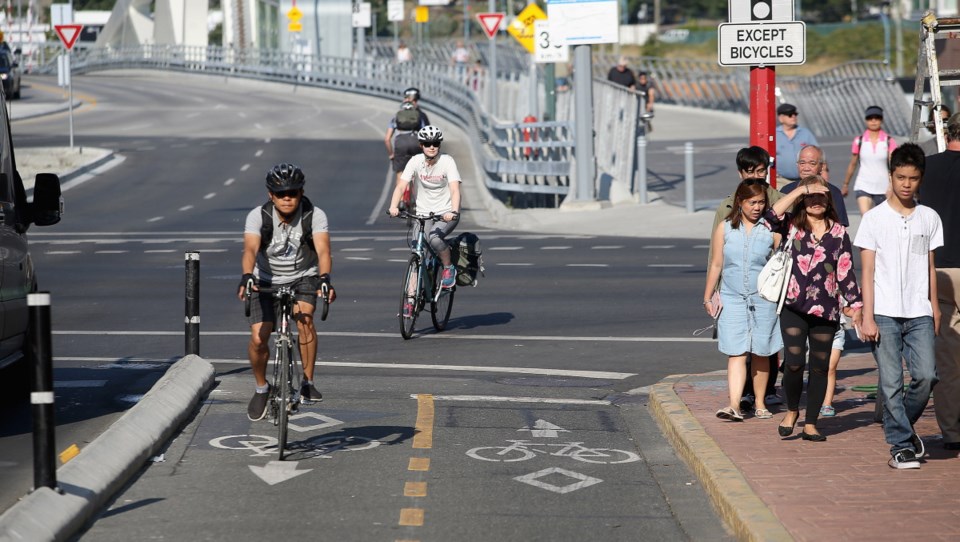If you were to believe letters to the Times Colonist or postings on local-issues websites, the new protected bike lanes in downtown Victoria are a harmful waste of money. However, critics ignore the large benefits that these facilities provide.
Let me summarize the business case for building Victoria’s bicycle network.
For an optimistic perspective on downtown bike lanes, watch rush-hour traffic at Pandora Avenue and Wharf Street — Swan’s Pub is a perfect location. You’ll see a steady stream of bicyclists, including commuters in suits, parents with children, shoppers, delivery bikes and tourists. Without the protected bike lanes, fewer of these trips would be made by bicycle and many would have been made by car.
An abundance of solid research indicates that high-quality bike lanes increase bicycle use. For example, a recent study led by McGill University Prof. Seyed Zahabia, Exploring the Link Between the Neighbourhood Typologies, Bicycle Infrastructure and Commuting Cycling Over Time and the Potential Impact on Commuter GHG Emissions, predicts that a 10 per cent increase in a city’s bicycle network reduces automobile commute trips and emissions by approximately three per cent. This indicates that many people want to bicycle, but will do so only if there are suitable facilities. Protected bike lanes on urban arterials typically increase bicycle trips there by 50 to 100 per cent.
Bicycle improvements are particularly appropriate in our region. The 2016 Canadian census says that 6.6 per cent of regional commuters cycled to work, the highest rate in Canada, and the 2017 Capital Regional District Travel Survey suggests that 15 per cent of morning trips to downtown are by bicycle.
This provides many benefits, particularly when bicycling substitutes for driving. Bicycling costs less, requires less space for travel and parking, and generates less noise and air pollution than automobile travel. It also improves riders’ fitness and health and provides independent mobility for non-drivers, which reduces drivers’ chauffeuring burdens.
For some people, the ability to bicycle on busy roads is transformative, allowing them to save thousands of dollars annually and achieve physical-fitness goals. Everybody benefits, including motorists, from improved bicycling conditions and increased bicycle use.
Of course, bicycle facilities have costs. They cost millions of dollars to construct, can delay some turning manoeuvres and displace parking spaces, but these costs are more than offset if bicycle improvements cause small reductions in automobile trips.
The 2017 travel survey suggests that there are 3,820 bicycle trips to downtown each morning. If bike network improvements increase bicycle trips by just 20 per cent, and half of these replace driving, there would be 382 fewer car trips to downtown, which reduces total congestion delays, and roadway and parking-facility costs.
Bicycle improvements are also justified for fairness’ sake. Roads are public facilities financed by local taxes paid by all residents. You might prefer that your tax dollars be spent to expand roads for automobile traffic, but other citizens want more bicycle-facility investments. Bike lanes ensure that bicyclists receive a fair share of road space and transportation spending.
Fortunately, most motorists are considerate to bicyclists — thank you very much! But even responsible drivers are a threat to bicycling on busy roadways that lack adequate facilities.
Some critics want to stop building bike lanes or eliminate those that exist. That would be wasteful. Our region’s high and growing bicycling rates indicate that our bicycle-facility investments are effective and benefit many residents.
Of course, not everybody can bicycle, but everybody benefits if those who want to bicycle can do so comfortably and safely on all roads. Before complaining about protected bike lanes, please consider all the benefits they provide, and show a little generosity to your many neighbours who want to ride a bike.
Todd Litman is executive director of the Victoria Transport Policy Institute, an independent research organization based in Victoria.



